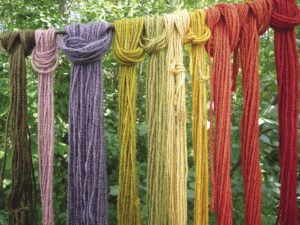Here’s a challenge: try going a day without using products that contain synthetic dyes. Or better yet, a few waking hours.
I tried and didn’t get far. After waking up and entering the bathroom to wash and dry my face, I paused at my towel. A mosaic of fuscia, purple, turquoise and black, these colors were almost guaranteed to be synthetically produced.
Our sensory world is saturated in dyes, coloring the everyday things we use: personal care products and cosmetics, clothing garments and textiles, food and packaging, the printing of this magazine.
There was a time when dyes were derived almost entirely from gathered plants—even insects. Author and artisan Judith Walter McGrath notes that in Mediterranean and Eastern countries, cochineal, kermes and other tiny insects were roasted and crushed into powder, producing dyes so valuable these bugs were cultivated as crops. It’s speculated that some of the oldest known fabric dyes were made from alchemical mixtures of soils, colored by minerals like iron and copper oxides.

Our universal quest for color has spurred trade and industry for thousands of years. Throughout history, people used plants, invertebrates and minerals that were locally available. Coveted dyeing recipes and techniques practiced by cultures around the world were guarded from foreigners. As the cotton craze swept through Europe in the 17th century, India’s master dyers already knew that vegetable dyes couldn’t penetrate the waxy microfibers of cotton—it had to be treated to make it receptive to colour. Indian artisans developed methods using the urine of goats and other farm animals, passing their wisdom from one generation to the next.
Dyes of South Asia, primarily madder and indigo, but also henna, turmeric, jackfruit, coral jasmine, logwood and fustic originally came from a plant’s leaves, tree bark, seed or roots.
But other dyes were rare, especially those that came from the sea. In roughly 1600 B.C., dyers in Crete discovered that a brilliant, non-fading scarlet could be extracted from the murex shellfish, later called Tyrian purple. Other shellfish produced purplish colors ranging from red to black. Worn by the privileged few, they became the exclusive colours of church, royalty and state. It wasn’t until chemist William Perkins discovered how to draw an intense purple color from coal tar in 1856 that the commercial dye industry took hold.
In our hemisphere, it may sound surprising that some of these colours can be found into the far reaches of the Canadian Arctic. Most species produce predictable but rich browns, yellows and oranges, certain lichens can dye purples, pinks, and even blue.
Plants harvested from the wild or cultivated in your own back yard can offer a range of colours and shades: the yellow of burdock, magenta of elderberry, mossy greens and yellows of St. John’s Wort, muted grey-blues of purple corn husk and black hollyhock. Certain chemical washes or mordants, are needed so the colour can “bite” into the fibre to make it last. Some mordants, like baking soda, can bring out vibrancy and brightness in a color, while others like iron can produce darker or more muted tones.
When I dyed wool from the plants mentioned above and hung them on a clothesline to dry, the colors could be arranged in any order—none of the combinations seemed to clash. Nature’s colors can be wild, impressive, and even unpredictable, but they’re all part of the same palette.
It can be a lot of fun to experiment with different mordants and saturation times on skeins of wool. Try it yourself—if you’re not sure where to start, there may be a crafts person or local artisan who can show you; and there’s always the library and online videos. Results aren’t always consistent, especially when you’re dealing with variables like treatment time, concentrations of the plant mixture, and even the time of year when the plant was harvested.

